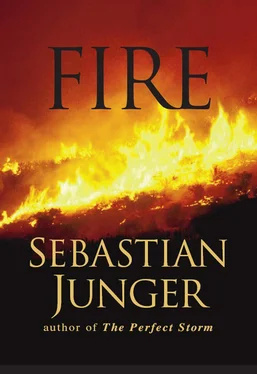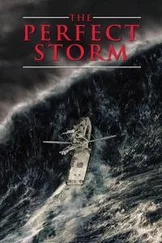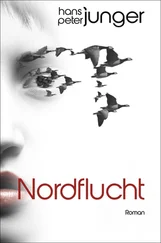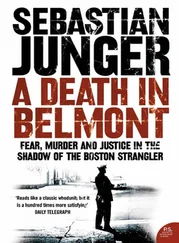A type one overhead team is called in only when a fire is really bad or is expected to get really bad. The Flicker Creek fire was in steep terrain with extremely dry fuels and strong winds. Steep slopes help a fire because uphill fuels get preheated; winds help a fire because they make it burn hotter and push it across the land. A seven-hundred-acre fire could jump to seven thousand or even seventy thousand in no time at all.
An hour later I was driving north on Highway 21 in my green fire-retardant Nomex pants and yellow fire shirt. In the back seat were a yellow plastic hard hat and a fiberglass and aluminum fire shelter. The shelter is a pup tent that comes in a small pouch with belt loops. It reflects radiant heat, reducing what would be a 1,000-degree fire to 120 degrees or so. I would be assigned a public relations person when I got to the fire camp, the ranger told me. I would be fed and I would be lodged in a tent if I didn’t have one. Tomorrow morning a helicopter would take me into the fire line.
I breezed past some bored Forest Service guards and turned off Highway 21, into the hills.
Flicker Creek is one of hundreds of small creeks that cut through the steep, dry hills of the Boise National Forest. Most of the land is grass and rocks and sagebrush, with heavy stands of ponderosa on the north slopes and in the drainages. Flicker Creek empties into the North Fork of the Boise River, which quickly joins the Middle Fork and continues on to fill the Arrowrock and Lucky Peak reservoirs. The entire West was seven years into one of the worst droughts since the 1870s, so both reservoirs were severely depleted. Arrowrock had been reduced to a muddy brook that you could practically jump across.
After twenty miles of rough driving, the road leveled off along the North Fork of the Boise. There was plenty of water up here—or so it looked—and the river was fast and lined with big, open stands of ponderosa. The fire camp was in a huge meadow called Barber Flats that ran alongside the North Fork of the Boise. Hundreds of bright nylon tents were pitched in the yellowed grass. A helicopter thumped over a ridgeline, trailing a retardant bucket. Water trucks rumbled back and forth, spraying the dust down. Hotshot crews came and went, Indian file, or slept in the shade, or sharpened their tools. Some were black with dirt; others looked as if they’d just arrived. They all had on the same green and yellow Nomex that I wore and big lug-soled boots.
I parked my car between the trucks and water tankers and searched out the information desk. The public affairs people knew I was coming, and I was pointed toward a large, deep-voiced man named Frank Carroll. “You’ll need boots if you want to go out on the line,” he told me. “You’ll need water bottles; you’ll need food; you’ll need gloves. I’ll set you up after dinner. You can pitch your tent anywhere you like. People get going around five in the morning; make sure you’re at breakfast and ready to go by then.”
I thanked him and went off to get my gear set up. All around me, big, lean men and a few women went about their duties. I pitched my tent in tall grass behind a cabin that served as a command post and then wandered over toward the catering tent. Behind it was a full-size truck outfitted as a kitchen. Hotshot crews passed by it in line, taking plates of food from the young woman behind the window and then sitting down at folding tables under a canvas army tent. The woman was pretty and had a sheath knife on her belt. I tried to pretend I belonged there, and she loaded my plate up with steak and carrots and mashed potatoes and salad and two slices of white bread.
I took a seat by myself at a corner table and watched the crews come and go, talking loudly, eating fast. Most of the fire fighters were young white men, sinewy and unshaved. There was a scattering of women among them, but the women were treated—as far as I could tell—no differently from anyone else. I didn’t think they would be discriminated against so much as subjected to one form of gallantry or another, but they weren’t. Everyone seemed to be too tired and hungry to notice the opposite sex. (This turned out to be emphatically untrue.) Furthermore, beneath the baggy clothes and grimy faces it was hard to tell who was what.
The Indians and Latinos generally had their own crews. It was a reflection of demographics more than anything else: Twenty men from Browning, Montana, are likely to be Blackfeet, not white; twenty men taken off the farm crews in the Snake River valley are likely to be Latino, not Indian. It’s the Indian crews, the caterer told me, that can really clean out a food truck. “They’ll eat anything that’s not nailed down,” she said. The convicts eat sweets and spicy foods because they can’t get much of that in prison. The white ’shot crews are the most health-conscious: They eat a lot of fruits and vegetables; some won’t even touch meat.
That was hard to imagine, because the government food contracts were defined by how much protein—meat, in other words—was provided per person per meal. Everyone gets four ounces of meat at breakfast, seven ounces at lunch, and ten to sixteen ounces at dinner. Everything else—vegetables, grains, fruit—was considered a condiment and didn’t figure into the equation. It’s a lot better than it used to be, though. Back in the dark ages of fire fighting—before women, before showers, before Nomex—the crews subsisted mostly on ham.
Ham and eggs, ham sandwiches, fried ham. Catering trucks were essentially big meat lockers with ham hanging in them, and maybe some Wonder bread. Back in those days the hotshots wore T-shirts that said, “When forests burn, pigs die.”
After dinner I sat in on the planning session. It was held under a ponderosa pine by the dirt parking area. The entire overhead team was there, identifiable by the fact that they weren’t dirty and weren’t wearing Nomex. They were trained together and used on the Flicker Creek fire as interchangeable parts of a network called the Incident Command System. The system is based on the idea that any person trained for a certain job—logistics chief, information officer, helibase manager—can perform that job for any agency, in any situation. Overhead teams are made up of people from a dozen different government agencies and are pulled in from all over the country. You might find an incident commander from Georgia and an air operations branch director from Colorado and a safety officer from the next town over. There are seventeen type one overhead teams in the country, and they mainly fight fires, but they have also been effective on other catastrophes: oil spills in Alaska; hurricanes in Florida; earthquakes in Mexico. An overhead team was sent to clean up the Valdez oil spill, for example, and the system worked so smoothly that it was copied by both the Exxon Corporation and the U.S. military. A fire camp with an overhead team, in fact, can put two people in the field for every one person acting as support—a ratio roughly twenty times as efficient as the military’s.
Iwent to bed when the five hundred fire fighters did, at dark. The only noise was the continuous rumble of the generators. The planning session had brought bad news, in a way: The fire was cooperating almost too quickly. A thirty-acre spot fire had started in light fuels on the south front but had been contained by three crews. Seven type two crews—less experienced than hotshots and usually used for mopping up—had cut line all the way down to the river, farther than expected. The winds were dying down, and unless they picked up again, the fire would be contained within days.
A fire camp is never completely still. All night long I was aware of the movement of men. They walked past, packed equipment, coughed, spat. Around four in the morning the sounds were so continuous that I woke up even before my watch alarm went off. It was still dark, and the camp undulated with human forms and occasional headlamps. Crews were packing their line gear, drifting toward the catering tent, clustering around the big stand-up kerosene heaters set up at intervals in the field. It was cold, maybe in the twenties. I crawled out of my sleeping bag and pulled on several sweaters and my boots—I had to wear leather on my feet in the helicopter, for some reason—and hustled toward the lights of the tent.
Читать дальше












